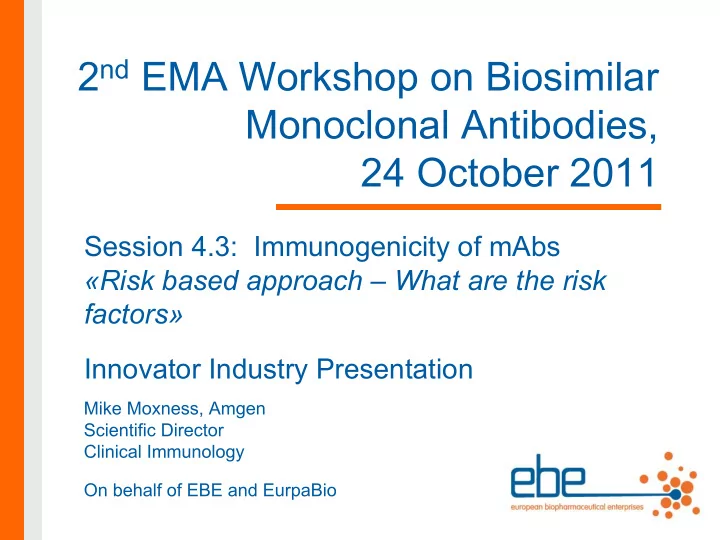

2 nd EMA Workshop on Biosimilar Monoclonal Antibodies, 24 October 2011 Session 4.3: Immunogenicity of mAbs «Risk based approach – What are the risk factors» Innovator Industry Presentation Mike Moxness, Amgen Scientific Director Clinical Immunology On behalf of EBE and EurpaBio
Immunogenicity Assessment of Monoclonal Antibodies Using a Risk-Based Approach On behalf of EBE, we consider unwanted immunogenicity of mAbs to be an important clinical concern and appreciate the opportunity to participate in the development of this guideline Contributors: Abbott: Ingeborg Dreher Amgen: Michael Moxness (Presenter) BMS: Martin Ullmann LFB: Françoise Rossi Merck KGaA: Beatrix Metzner Novartis: Peter Lloyd Pfizer: Judith MacDonald Roche: Valerie Quarmby, Anna-Maija Autere, Julia Heinrich
Risk-Based Immunogenicity Assessments EBE welcomes a clinical risk-based approach • Which should be applied for each novel and biosimilar mAb - Each indication may require a separate risk assessment - Likelihood of an immune response is related to product, process • and patient specific risk factors; unique risk factors for mAbs include: More micro-heterogeneity than other biologics - Higher dosing and longer half-life, therefore, significant exposure to low level - product variants and process impurities can occur Idiotypes that may appear foreign to the immune system - Severity of an immune response is often limited to loss of efficacy • and/or hypersensitivity; unique risk factors for mAbs include: Immune complex formation in the presence of high drug and anti-drug antibody - (ADA) concentrations which leads to enhanced clearance and/or adverse events ADA cross-linked mAbs may induce unexpected agonistic or antagonistic activity -
Perceived Risk Drives the Extent of Clinical ADA Testing and Characterization Appropriate methods and sampling strategies should be used to • detect ADA responses in studies where high drug concentrations are expected Impact of ADA on PK, PD and efficacy may be used as a surrogate • for neutralizing activity in some circumstances Drug-specific IgE assays may be needed if allergic reactions are • observed and there is an identified potential for hypersensitivity Post-authorization monitoring of ADA (and potential impact) may be • necessary if pivotal studies are not adequately powered for rare events
Other Recommendations for Clarification in Final Guidance Document Immunogenicity strategy may be different for biosimilar mAbs • Primary goal is to establish similarity with sufficient clinical data pre-approval, - acknowledging that post-authorization monitoring may also be necessary Data should be generated in a direct comparison of innovator and biosimilar - mAbs using state-of-the-art assays and appropriate sampling Extrapolation considerations should include a risk-based assessment, however, - more experience is necessary to validate this approach Immunogenicity strategy may be different for mAb analogues • Fc-fusions, mAb conjugates, mAb fragments and mAbs with multi-functional - domains may require ADA epitope characterization and/or multiple assays to define binding and neutralizing activities Sponsors should determine whether to conduct in silico / in vitro • T cell assays to predict immunogenicity potential, since they are not yet clinically validated
Immunogenicity Risk Based Approach Summary EBE welcomes a risk-based approach for immunogenicity • assessment of mAbs, acknowledging: Likelihood risk factors are predominantly related to product, process and - patient, but also include extensive micro-heterogeneity of mAbs and high circulating drug levels Severity risk factors are predominantly loss of efficacy and hypersensitivity, but - also include unexpected activity due to cross-linking and enhanced clearance due to immune complex formation Post-authorization monitoring may be necessary in some cases - Assessment of neutralizing potential and allergic reactions requires careful - consideration of assay capabilities Clarification is requested for: • Differences in strategy for biosimilars and novel mAb-based analogues - Whether it is a choice or a requirement for the sponsor to conduct - immunogenicity prediction assays
Recommend
More recommend